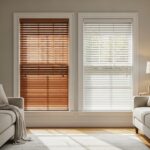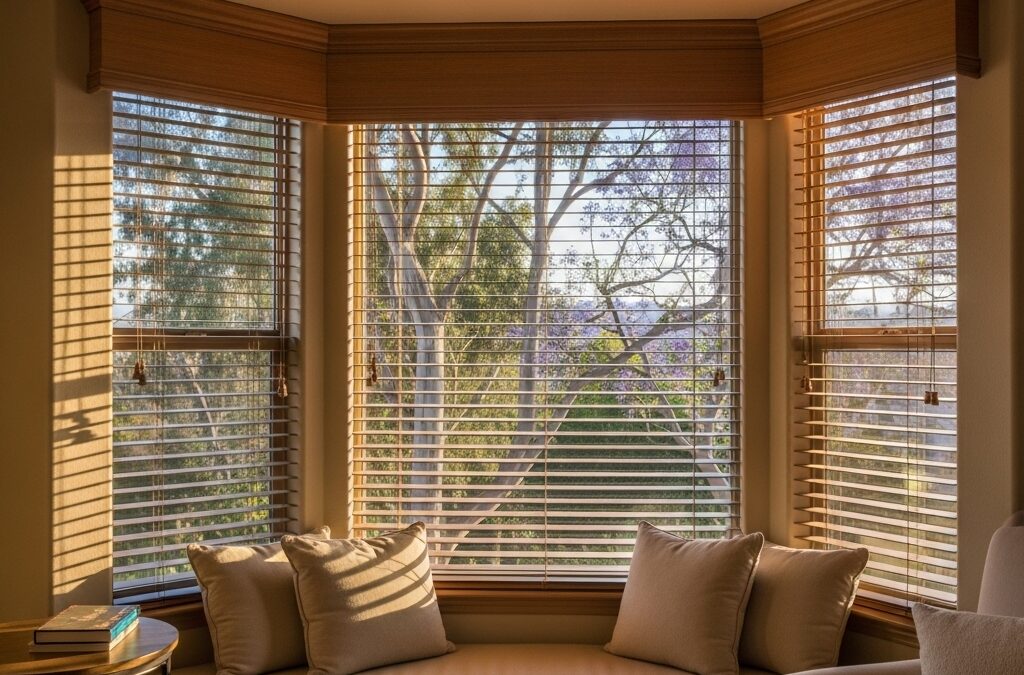
Custom Shutters Maintenance Tips for Simi Valley California Homes
November 21, 2025
Wood Blinds vs Faux Wood Blinds for Simi Valley California Homes
November 21, 2025If you live in Simi Valley, you know the way our light moves. Mornings glow soft and golden across the Santa Susana foothills, afternoons blaze with crisp clarity, and evenings tilt amber as the sun slips behind the ridgelines. Bay windows in our neighborhoods—whether you are in Wood Ranch, Big Sky, the Knolls, Santa Susana, or on a quiet cul-de-sac near Royal Avenue—have a front-row seat to that performance. They pull light into the heart of a room, frame views of eucalyptus and jacaranda, and carve useful nooks for reading, dining, and daydreaming. But as elegant as they are, bay windows can be tricky to dress. The angles, the projection, the need for privacy without losing sunlight, and the way heat builds in late afternoon all call for thoughtful solutions. That is where custom wood blinds stand out: they fit like a suit tailored to your window and your lifestyle, all while bringing natural warmth you can feel the moment you walk into the room.
From the first consultation, the goal is to capture the charm of your bay while taming glare and managing heat. The right finish can echo a rustic oak floor or a clean white trim; the right slat width can open sightlines while keeping neighbors from seeing in after dusk. If you have been considering options, take a close look at wood blinds for their balance of beauty, durability, and control in our specific Simi Valley climate.
Why Bay Windows Deserve a Custom Approach
A bay window is not a single flat span; it is a composition of three or more faces set at angles that change the way light enters. In Simi Valley, where the sun can be bright and direct for most of the year, those angles become magnifiers at certain hours. The center panel may glow while the flanks are shaded; at other times, glare bounces across the room. Off-the-shelf solutions rarely align with those nuances. Custom wood blinds allow each face of the bay to be measured to the eighth of an inch, ensuring every panel sits plumb and level with tight, consistent reveals. That precision matters visually, but it also matters for performance. Proper fit reduces light leaks along the sides, which can otherwise shoot a harsh beam across a desk or television. It also aids insulation by minimizing gaps where heated or cooled air can escape.
The Beauty and Performance of Real Wood
Real wood brings a tactile presence that synthetics struggle to mimic. Run your hand along a finely finished rail and you feel the grain, the subtle weight, and the craft. In design terms, wood introduces a grounded, organic line into the architecture of your bay. In performance terms, high-quality hardwood slats resist bowing when sized properly for the opening, and they are lighter than many alternatives, which keeps operation smooth. In Simi Valley’s dry Mediterranean climate, wood performs well when correctly sealed, resisting the minor humidity swings we experience between coastal influence and hot inland days. A professional-grade finish protects against UV fading and helps the slats wipe clean without absorbing moisture, an important detail when late-afternoon rays press hard on west-facing windows.
Choosing Slat Size for Simi Valley Light
Most homeowners gravitate toward 2-inch or 2.5-inch slats in a bay window. The difference is more than looks. A wider slat can create a broader view when tilted open, which is nice if your bay captures hillsides or a flowering garden. It also reduces the number of horizontal lines, simplifying the appearance, particularly if your home leans modern or transitional. A 2-inch slat, on the other hand, can be a great match for traditional casings or smaller bays, keeping proportion and scale in harmony. In practice, we look at the bay’s height, your seating position, and how much sun you want at certain hours. If you read at the bay in the morning, a tilt angle that bounces light upward toward the ceiling may work well. If afternoons bring glare on a laptop, a slightly closed tilt at eye level can soften harshness without darkening the entire room.
Mounting Details: Inside, Outside, and Mitered Solutions
Installation is where custom shines. Each face of the bay is measured individually, taking into account any out-of-square corners or casing variations. Inside mounts preserve the architecture by tucking the headrail neatly into the opening, while an outside mount can help if your bay’s returns are too shallow or if you are seeking a more substantial, dressed appearance around the frame. Many Simi Valley bays are deep enough for an inside mount, which highlights the crisp points where the faces come together. For a particularly polished look, mitered valances can be custom cut so that the header trim meets perfectly at the angles, reading as one continuous, intentional line rather than three unrelated pieces. That kind of detail turns a practical installation into a crafted feature.
Color, Grain, and Finish for Local Architecture
We have a variety of architectural styles across Simi Valley, and finish selections can respect those contexts while still expressing your taste. In a Spanish revival or Mediterranean-influenced home, a warm mid-tone stain can resonate with clay tile and wrought iron accents while keeping the room fresh. In a ranch-style or craftsman-inspired home, a knot-free, satin-finished basswood with a soft white or cream paint can amplify trim work and reflect light, making smaller alcoves feel more open. Contemporary spaces often benefit from cooler neutral paints or a bleached oak look that nods to Scandinavian simplicity. Whatever your setting, consistency matters: aligning the blind color with your baseboards, crown, or window casing creates a visual thread that unifies the room. And because Simi Valley’s sun is strong, we favor finishes with excellent UV inhibitors to help keep whites crisp and stains true.
Privacy Without Losing the View
One of the joys of a bay is its connection to the outside. You want to retain that, even when privacy is a priority. Wood blinds give you micro-adjustability: a slight downward tilt as dusk settles will block direct sightlines from the street while leaving plenty of ambient daylight. During the day, a gentle upward tilt can bounce sunshine onto the ceiling, diffusing it evenly through the space. For bedrooms that face the street, routing options can reduce pinholes of light. No-route or hidden-route constructions eliminate the center holes found on many slats, tightening privacy and dimming rooms more effectively. In family rooms, traditional routing is often sufficient, and the slightly greater glow can feel more welcoming than blackout levels.
Operation: Cordless, Wand Tilt, and Motorization
Because a bay often invites seating right up to the glass, the way blinds operate really matters. Cordless lift keeps sills clean and clear, ideal for window seats where cushions and pillows can snag cords. A wand tilt offers intuitive control for everyday use, and because wood blinds are inherently durable, the tilt mechanism is built to handle frequent adjustments as you follow the sun. For hard-to-reach center panels or tall bays, motorization is a practical luxury. Modern systems pair with wall switches or remotes, letting you tilt or raise slats with a tap. If your bay faces west and you regularly battle afternoon glare while preparing dinner, a quick tilt from across the room can make all the difference.
Energy and Comfort in a Valley Climate
Simi Valley’s hottest months can push interior temperatures if windows are untreated. Wood blinds help by creating a barrier that breaks up direct rays before they reach your furnishings and floors. When slats are angled to reflect, rather than absorb, light, you will feel a perceptible difference in comfort. In winter, closing slats snugly at night adds a layer of insulation that reduces drafts around glass. While blinds are not a substitute for high-performance glazing, they are a meaningful contributor to day-to-day comfort, especially in bays where glass area is substantial.
Layering With Drapery or Shades
Some bays look best with blinds alone, clean and architectural. Others benefit from a soft layer. A stationary panel at the far edges of the bay, kept outside the glass, can frame the view, absorb sound, and introduce texture without interfering with operation. Roman shades mounted above the bay can add pattern or color while leaving blinds to do the work of daily light control. The key is coordination, not clutter. Keep lines simple, let the angles of the bay remain visible, and think about how fabrics will read in our bright, low-humidity air—colors often appear more saturated in late-afternoon light, so samples in place are valuable.
Measuring and Planning: Avoiding Common Pitfalls
Two details often overlooked are depth and projection. Measure the narrowest points inside each face of the bay, not just the center, and confirm that mounting brackets and the tilt mechanism will clear handles, cranks, or alarm sensors. Check that the blind, when raised, will not collide with a transom or crown detail. For a picture-perfect result, ensure the bottom rail alignment is consistent across the bay, especially if sills vary slightly in height. Custom means these issues can be designed around before a single screw goes in, saving you from compromises later. In Simi Valley’s many tract homes, bays can be nearly identical from house to house, but we still find small variances—drywall build-up, past paint layers, or a slightly out-of-square corner—that matter for a crisp fit.
Mid-project decisions are opportunities to refine the whole room. As you finalize slat size and operation, consider the broader palette: hardware finishes in your kitchen, the stain of a nearby stair rail, or the character of your flooring. Repeating a tone or finish builds cohesion, making the bay feel integrated rather than added on. When you select custom wood blinds, you are not just picking a covering; you are establishing a repeatable language that can extend to other windows, keeping the home’s atmosphere consistent from space to space.
Living With Wood: Care That Fits Real Life
Maintenance for wood blinds is simple when it becomes a rhythm. Dusting slats with a gentle cloth or vacuum brush every week or two prevents build-up that can dull finishes, especially in the season when winds carry fine grit through open windows. For spots, a lightly dampened cloth followed by a dry wipe keeps the finish happy. Avoid harsh cleaners and too much moisture; the sealed wood is resilient, but care preserves that fresh-from-install look. In Simi Valley, where many of us leave windows open in the evening, a quick pass on weekends tends to be all it takes to keep blinds looking new.
Local Insights: Orientation and Daily Use
The direction your bay faces influences how you will use your blinds. East-facing bays welcome breakfast light; a shallow downward tilt softens glare without losing cheer. South-facing bays receive steady sun; adjust throughout the day to balance brightness. West-facing bays need the most attention between three and six in the afternoon—tilting to reflect rays upward prevents hotspots across sofas and floors. North-facing bays offer diffuse light most of the day; blinds can be kept open wider, with occasional tweaks for privacy at night. The point is not to fuss, but to let the blinds work with you. When tilt becomes second nature, comfort rises and you hardly notice the moments you make small adjustments.
Installation Day: What to Expect
A good installation is quiet, careful, and clean. Protecting sills and flooring, pre-drilling for brackets, and test-fitting each headrail ensure the final set is snug and square. In bays, we confirm that each blind clears the next during operation and that valance corners meet seamlessly if mitered pieces are used. Before we leave, we walk through tilt smoothness, lift function, and the quirks of your particular sun patterns so you feel confident using every feature. The goal is not just a beautiful reveal but an intuitive experience that fits your day.
Frequently Asked Questions
Will wood blinds warp in Simi Valley’s heat?
Quality hardwood blinds are kiln-dried and sealed to handle the dry, warm conditions common here. Sized correctly and finished with UV-resistant coatings, they hold their shape well. Choosing appropriate slat widths and avoiding excessive moisture during cleaning further supports long-term stability.
Are wood blinds a good choice for a breakfast nook bay?
Yes. They provide adjustable control to cut morning glare without losing that welcoming glow. Selecting a lighter finish can amplify natural light, and cordless lift keeps the nook tidy and safe for everyday dining.
Can I match my existing trim color?
Absolutely. Painted finishes can be color-matched closely to your casing and baseboards, while stains can be tuned to echo nearby flooring or furniture. Viewing samples in your bay at different times of day is the best way to land on the right tone.
What about motorization for tall bays?
Motorized tilt is a smart upgrade for hard-to-reach panels. Remotes and wall switches offer quick, quiet adjustments. If you have arched or very high bays, motorization reduces strain and helps you use your blinds as intended throughout the day.
Do I need no-route slats for privacy?
No-route or hidden-route slats enhance privacy by eliminating center holes, which can leak pinpoints of light at night. Bedrooms and media rooms often benefit, while living spaces may do well with traditional routing for a softer glow.
How do wood blinds compare to shutters in a bay?
Shutters create a permanent architectural statement and add depth, while wood blinds are lighter in scale, easier to raise, and more flexible for daily control. In bays where seating and sightlines matter, blinds can feel less intrusive and easier to live with.
Are wood blinds appropriate for a kitchen bay?
Yes, with the right finish and placement away from direct steam. Regular light cleaning handles cooking residue, and properly sealed slats resist minor moisture. For sinks directly within a bay, careful operation and routine wipe-downs keep everything fresh.
When you are ready to elevate your bay window with a solution that looks tailored, feels intuitive, and makes each day more comfortable, reach out for a personal consultation. We will measure precisely, guide you through finishes that complement your home, and install with care so you can enjoy the transformation from the first afternoon sunbeam. Start by exploring the possibilities of wood blinds and imagine how your bay can become the warm, welcoming heart of your room.





